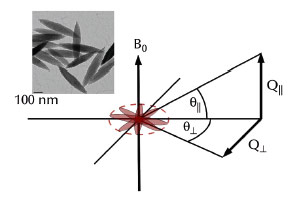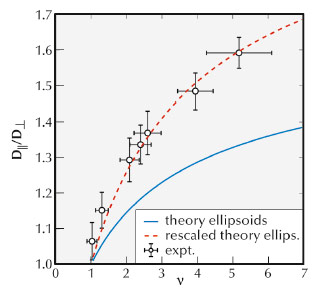- Home
- Users & Science
- Scientific Documentation
- ESRF Highlights
- ESRF Highlights 2013
- Soft condensed matter
- Direction-dependent diffusion of spindle-shaped hematite particles by means of X-ray photon correlation spectroscopy
Direction-dependent diffusion of spindle-shaped hematite particles by means of X-ray photon correlation spectroscopy
Colloidal particles consisting of hematite α-Fe2O3 align with their long axis perpendicular to an external magnetic field even at moderate flux densities of several millitesla. This is due to a negative anisotropy of their magnetic susceptibility. Monodisperse, spindle-shaped hematite particles can be prepared with a tunable aspect ratio ν – L/D defined by the length L and equatorial diameter D of the particles (Figure 84). Dark-field electron micrographs show that they are single-domain particles.
 |
|
Fig. 84: Transmission electron micrograph of spindle-shaped particles and schematic view of the scattering geometry of an ensemble of spindles aligned perpendicular to an external magnetic field B0. For scattering vectors parallel to B0, only diffusive motions perpendicular to the particle axis are probed. For scattering vectors perpendicular to B0, all angles 0 <Φ < 2π between the long particle axis and Q are realised. In this direction the average diffusion coefficient ‹D›Φ = (D|| + D⊥)/2 is probed. |
Dynamic scattering experiments probe the projection of motions in the direction of the scattering vector Q. Choosing the direction of the scattering vector Q parallel and perpendicular to an external magnetic field B, the diffusive motion of an ensemble of aligned particles can be studied in dependence on the direction of Q with respect to the external field. Due to the negative magnetic anisotropy of hematite, the spindles align with their long axis perpendicular to the external field, not like a compass needle. At a flux density of B = 120 mT, the particles are completely aligned perpendicular to the field direction [1]. The spindles, however, can still rotate freely around their short axis forming an ensemble of particles with an orientational distribution function (ODF) f(θ) = δ(θ– π/2) / (2π). Choosing Q parallel to the field, only diffusive motions perpendicular to the particle axis are probed in the direction of the scattering vector. In this direction, the diffusion coefficient D⊥ is directly accessible. Since the ODF does not depend on the polar coordinate Φ for Q⊥B, both diffusive motions in the direction of and perpendicular to the direction of the particle axis are observed. In this configuration, according to Fokker-Planck equation, the average diffusion coefficient ‹D›Φ = (D|| + D⊥)/2 is probed.
For the experiments, highly diluted suspensions of hematite particles in water were used. The water contained 10-3 molL-1 potassium chloride to screen electrostatic interactions originating from surface charges. The samples were sealed in quartz capillaries. All experiments were carried out at beamine ID10 at room temperature with an incident energy of 8 keV and a beam size of 10 x 10 µm2. The scattered intensity was detected using an avalanche diode with an aperture of 50 x 50 µm2 at a distance of 2.20 m from the sample. The intensity autocorrelation function of both the scattered intensity and the monitor signal, was obtained by employing a digital FLEX correlator. At a volume fraction Φ =103 with S(Q) ≡ 1 no translational correlations between the particles were observed. Under these conditions the particles diffusive freely.
For particles with aspect ratios 1 < ν < 5, the diffusion coefficients D⊥ and ‹D›Φ = (D|| + D⊥)/2 were determined from the first cumulants of correlation functions g2(Q||B,t) and g2(Q⊥Q,t). With these two quantities, the diffusion tensor of the axial-symmetric hematite particles was determined.
The ratio D|| / D⊥ which depends on the aspect ratio is compared to the theoretical prediction for prolate ellipsoids of revolution derived by Perrin [2]. Spindles differ from ellipsoids by apices forming singularities in the surface curvature of the mesoscale particles. For hematite spindles the ratio D|| / D⊥ increases significantly faster with the aspect ratio than predicted for ellipsoids and can heuristically be described via the rescaled Perrin ratio for ellipsoids (Figure 85).
 |
|
Fig. 85: Ratio of diffusion coefficients D|| / D⊥ for spindle-shaped particles in dependence on the aspect ratio ν. The solid line represents the prediction for prolate ellipsoids [2]. The experimental data can heuristically be described via a rescaled Perrin approach. |
These experiments demonstrate the capability of XPCS to probe slow dynamic processes in soft matter that depend on the direction. Since aligned soft matter structures play a key role in many technical applications, e.g. liquid crystals in displays or magnetic nanoparticles in ferrofluids, XPCS can help to monitor dynamic processes in such systems on mesoscopic scales of space and time. Hereby, XPCS can provide new insights that will help to optimise technical applications of soft matter.
Principal publication and authors
J. Wagner (a), C. Märkert (a), B. Fischer (b) and L. Müller (b), PRL 110, 048301 (2013).
(a) Institut für Chemie, Universität Rostock (Germany)
(b) DESY, Hamburg (Germany)
References
[1] C. Märkert, B. Fischer and J. Wagner, J. Appl. Cryst. 44, 441-447 (2011).
[2] F. Perrin, J. Phys. Radium 5, 497-511 (1934).



